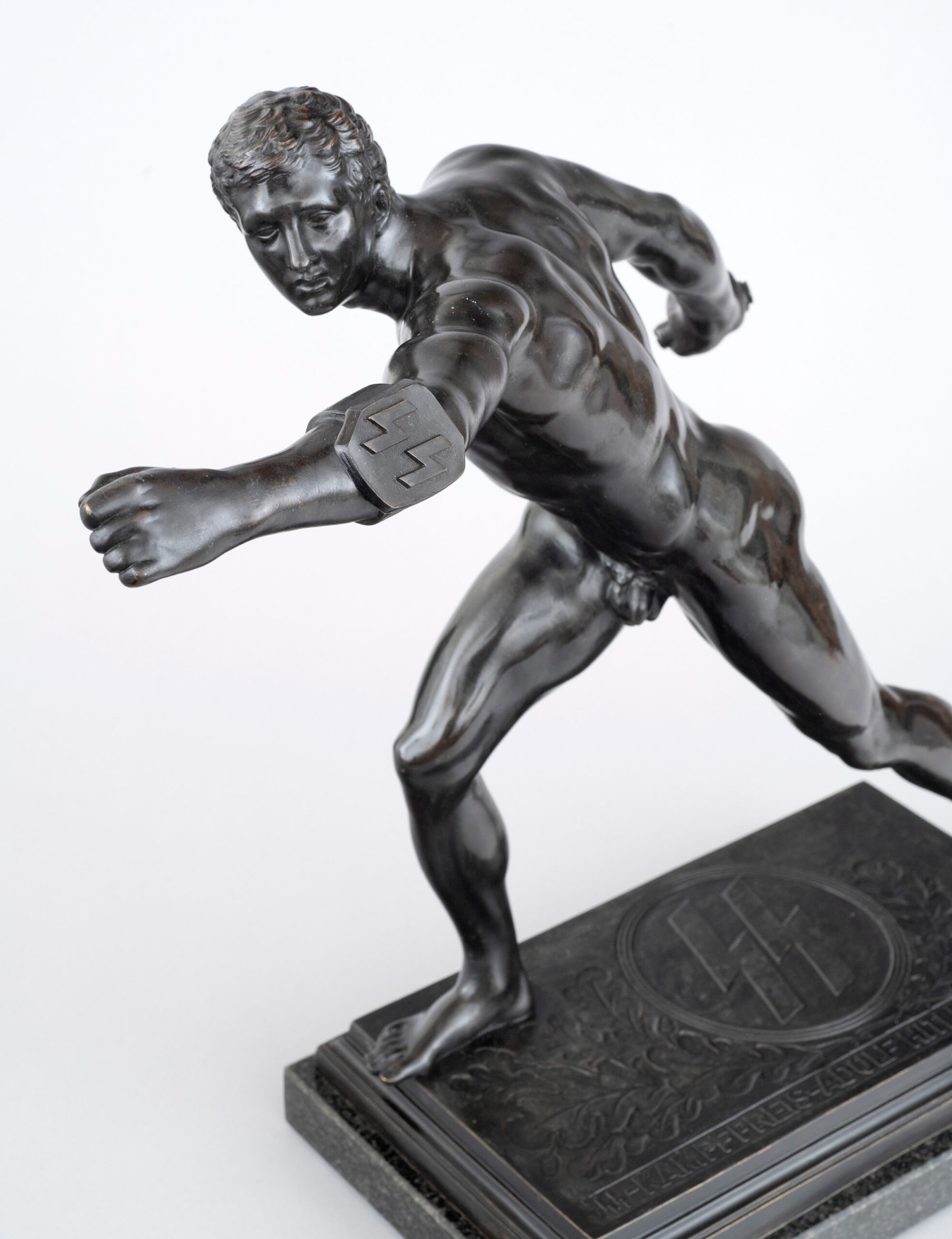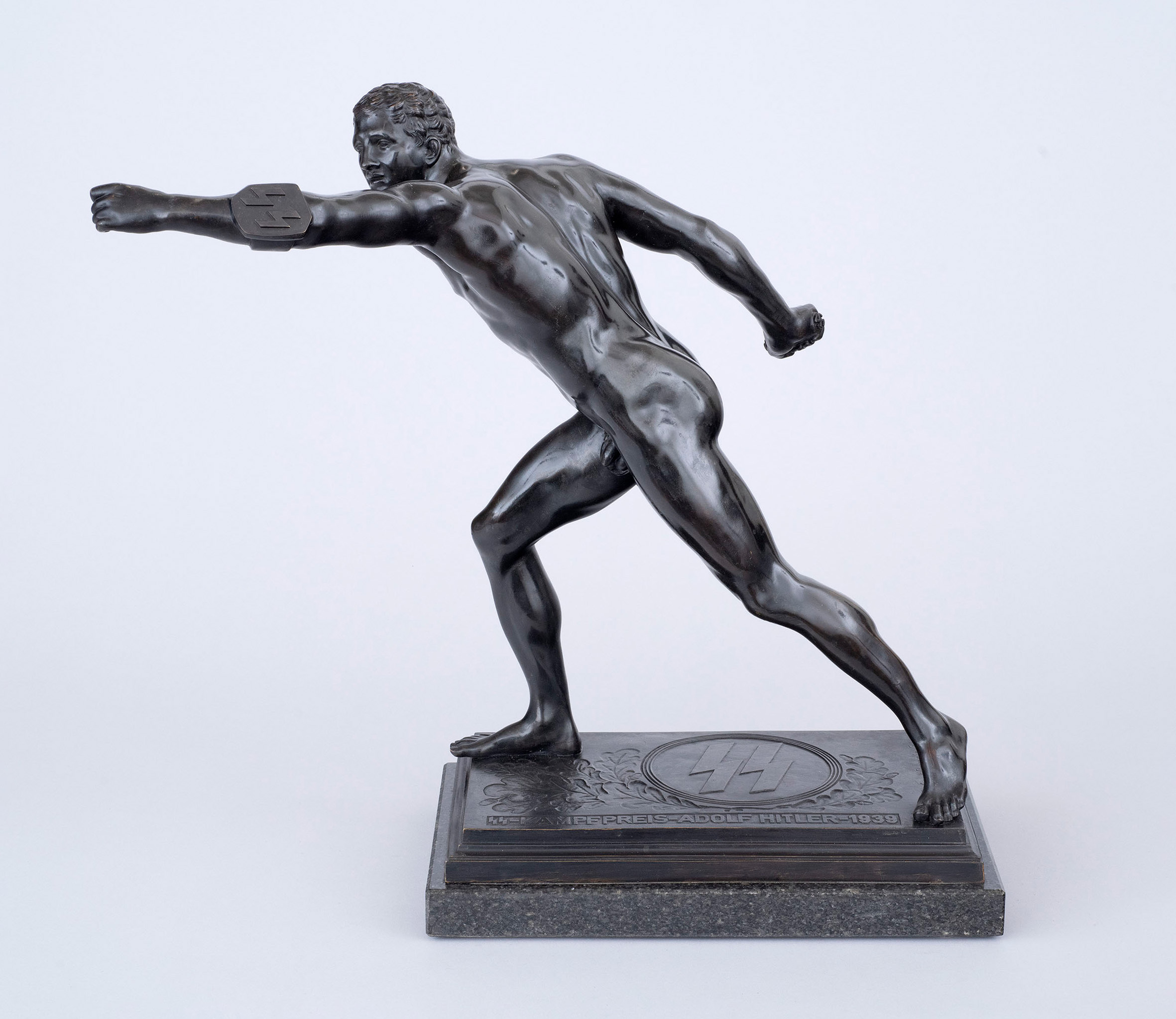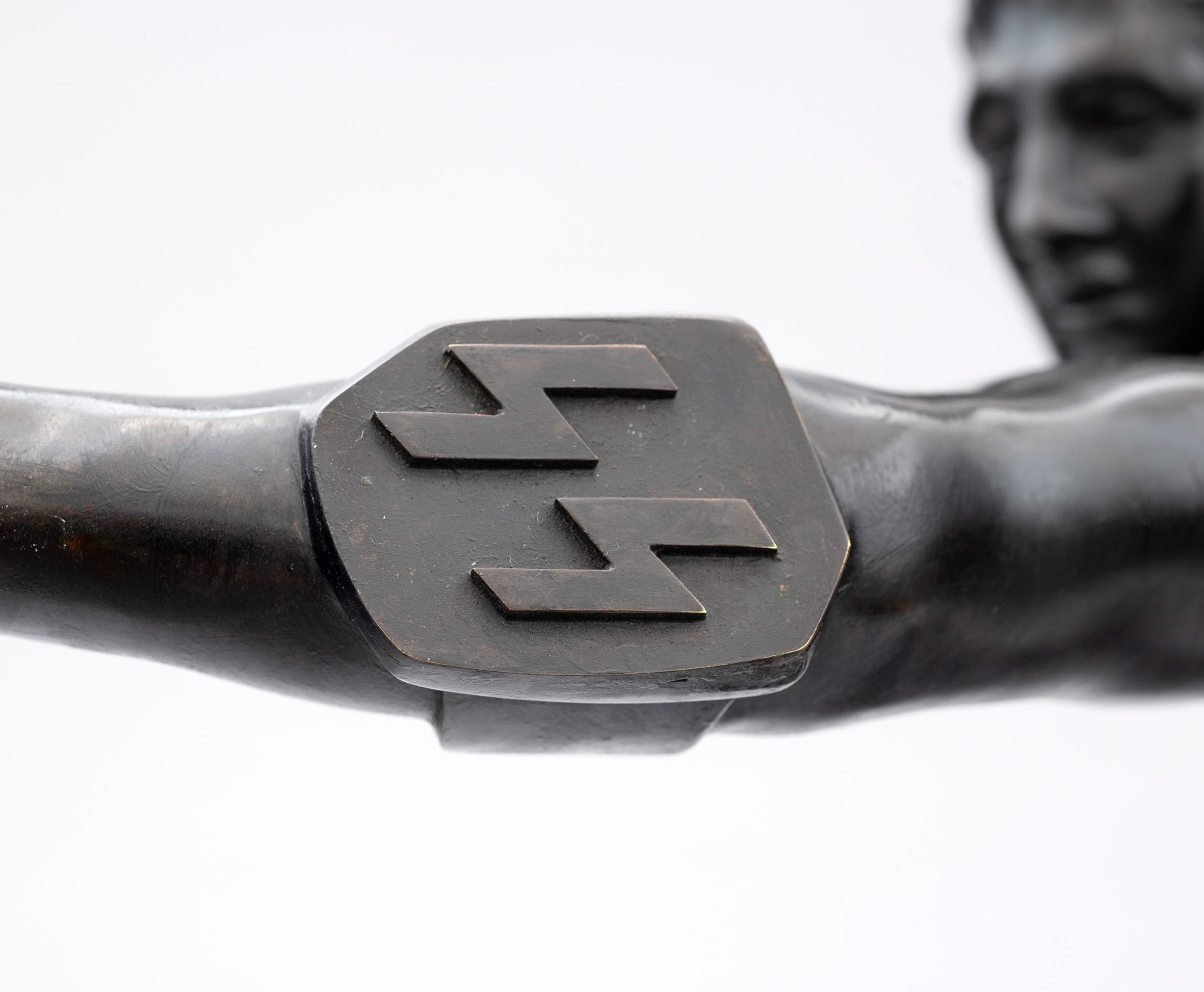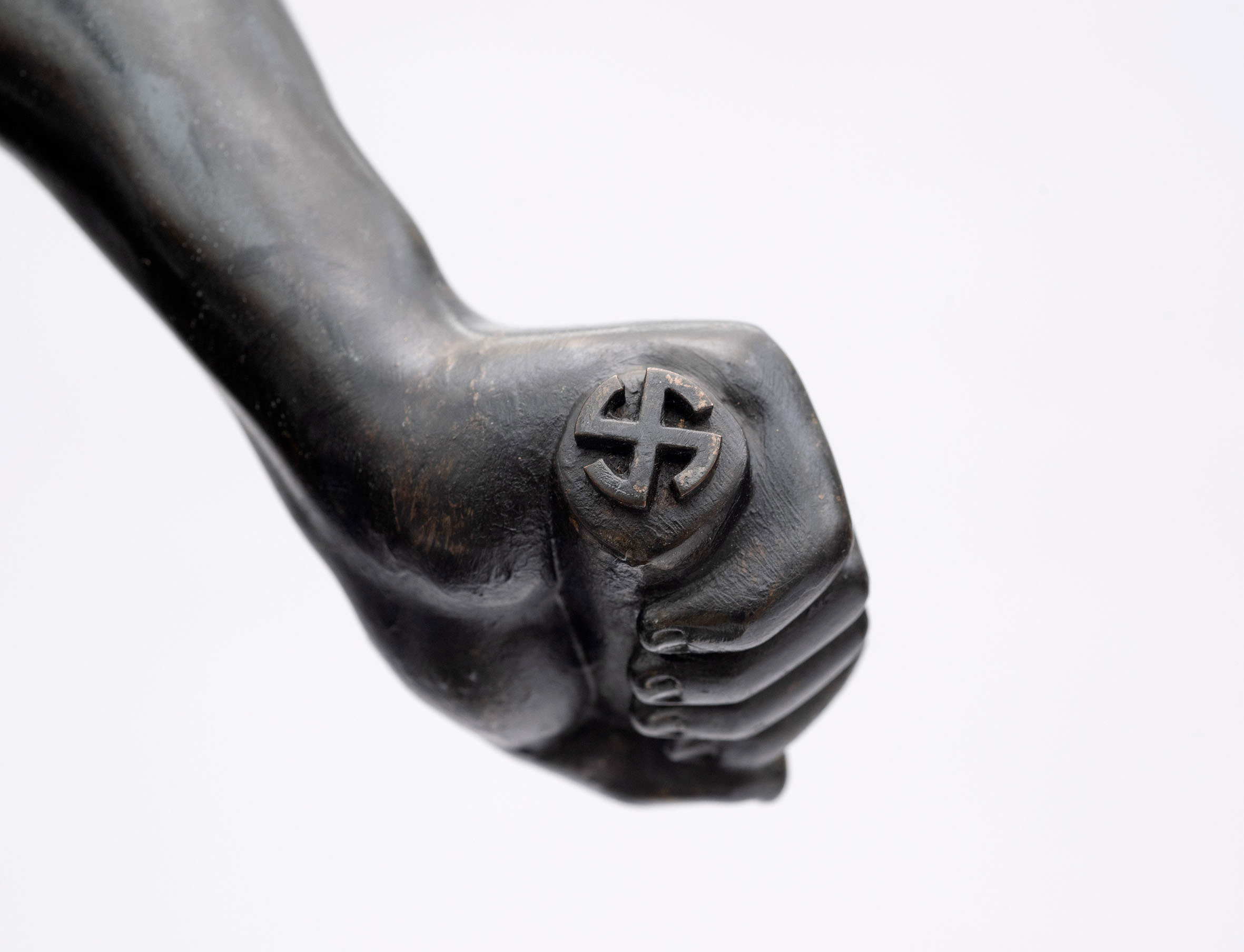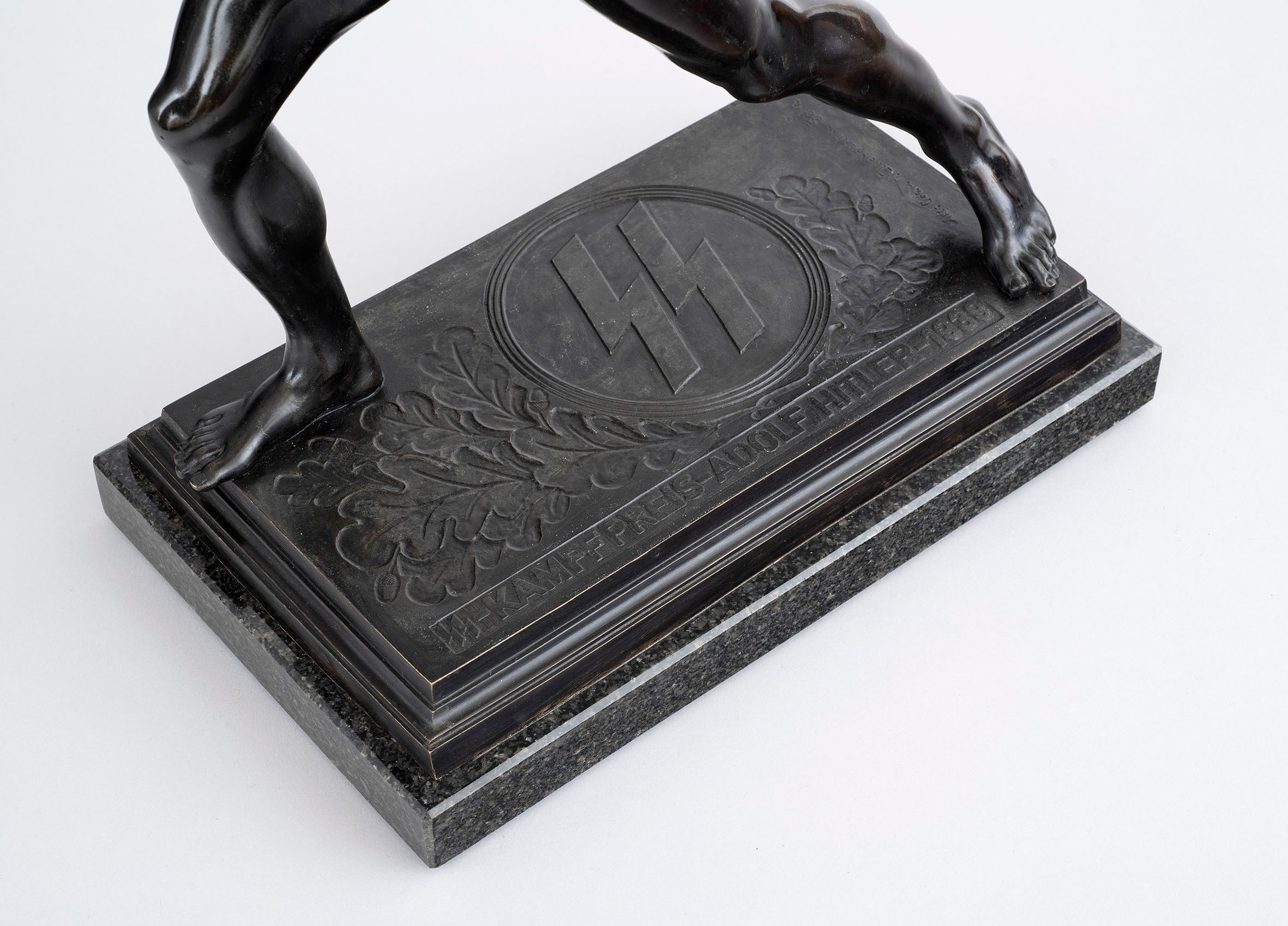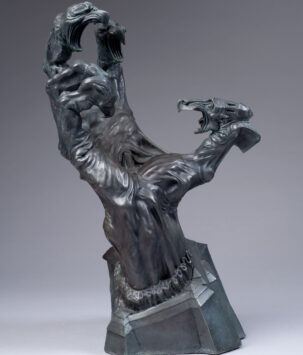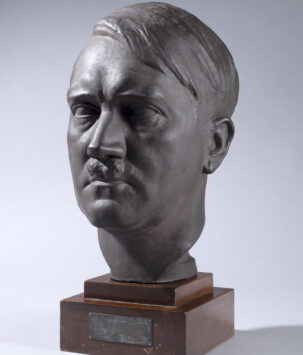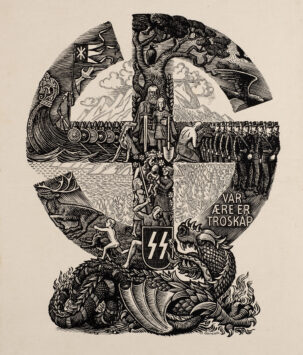SS-Kampfreis-Adolf Hitler-1939
Patinated bronze sculpture created as a prize for a contest held at an SS-Junkerschulen (SS cadet academy). Appears to be depicting an Olympian figure engaged in a relay race, equipped with a vambrace bearing the runic insignia of the SS, and a relay baton adorned by two (‘Thulean’ or rounded) swastikas on each end of it. This sculpture, alongside other similar prizes were awarded for contests held at various SS-Junkerschulen. The base of this sculpture is inscribed with the text “SS-Kampfpreis-Adolf Hitler-1939“, indicating that it was likely awarded at an SS-Junkerschulen contest held in 1939 in honor of the Führer Adolf Hitler.
Originally formed as SS-Führerschulen, these institutions were renamed SS-Junkerschulen in 1937 and served as the nation’s training and ideological indoctrination grounds for new officer candidates within the acclaimed Schutzstaffel (SS). The institutions were renamed Junkerschulen as a homage to the aristocratic Junkers of the Second Reich (Imperial Germany), with the SS envisioned as the new, racially defined aristocracy of the Third Reich (Nazi Germany). Rechristened as SS-Junkers, these newly trained officers would parallel the roles assumed by their knightly forebears and purify the Reich of its perceived enemies.
The ideology of the SS was underpinned by a nexus of esoteric, occult and mystical principles. Its four fundamental mythological pillars were that of Blut (blood), Boden (soil) Ahnen (ancestors) and Sippe (kin). According to the esoteric doctrine of the SS, the Aryans were originally a race of psychic extraterrestrial beings who founded the Lost City of Atlantis. After the deluge that led to the demise of their city, these ancient Aryans were said to have spread across the northern hemisphere, appearing in ancient Greek legends as the mythical Hyperboreans. Greek texts assert that the Hyperboreans inhabited the northernmost extremities of Europe and were characterized by their great stature and fair hair. This gave credence to the belief corresponding these Hyperboreans and their ancient Aryan ancestors with the contemporary Nordic race.
According to the SS, the Aryans were alleged to possess particularly desirable mental and physical characteristics bordering on superhuman. Mythologized for their military prowess and fortitude, these ancient Aryans served as inspirational and exemplary ancestral heroes for the SS to emulate. The Ahnenerbe think tank of the SS discovered traces of these desirable qualities to be found in considerably higher concentrations across the Germanic populations of northern Europe. The superhuman and psychic abilities attributed to the ancient Aryans are said to have diminished due to the dilution of their racial purity from centuries of racial interbreeding, with the ensuing logic being that these latent superpowers could be recovered through the selective breeding of pureblooded Aryans. The SS, its members supposedly exemplifying what remained of the finest order of Aryan racial stock, thus saw it as their mission to revitalize humanity through the creation of a superior “New Man” known as the ‘Übermensch’ through the selective proliferation of Aryan racial traits and the annihilation of others
This shared Aryan ancestry reinforced the notion of an ancient kinship existing between all members of the Nordic race which united them into a metaphysical racial order (Sippenorden), which members of the SS were expected to protect as its stalwart sentinels. Adolf Hitler was believed by some to be possessed by the collective Aryan psyche, and a metaphor can be drawn in which the Schutzstaffel (Protection Squadron) was protecting the collective Aryan soul which the Führer’s person embodied. As the pureblooded racial aristocracy of a new world order, the SS saw the conquering and settlement of ancestral and foreign territories not as a mere bureaucratic assignment but as a divine calling to safeguard the welfare of the coming master race as ordained by God. It was seen as an instinctive mandate, genetically encoded within Aryan blood that transcended traditional nation-state imperialism. In accordance with the four mythological pillars of the SS, these territories were to be turned into ethnically homogenous and agriculturally focused communities of shared ancestry (Ahnen), forming a vast, organic and agrarian utopia of kin (Sippe) bound by their blood (Blut) and the soil (Boden) from which they sustained themselves, with the ultimate goal of establishing the metaphysical Sippenorden as a tangible pan-Germanic polity. Employing such ontological, anthropological, and racial findings, the SS shaped National Socialist doctrine by crystallizing esoteric ideals into dogmatic truths for the state to enforce as policy and justifying German expansionism.
Reichsführer-SS Heinrich Himmler intended for the SS to be an elite paramilitary organization of ideological fighters, modeled upon religious knightly orders from history such as the Teutonic Knights. In order to carry out the impending racial crusade, ideological training was designed to foster an attitude of energetic ruthlessness, self-conscious determination and situational adaptability, an attitude succinctly reflected in the aggressive posturing of their very insignia. As the political vanguards of Nazism, the SS sought to distinguish themselves by incorporating such esoteric symbolisms and other mystical rituals to forge a sense of camaraderie within its ranks.
The egalitarian philosophy of National Socialism (from which its eponymous ‘socialism’ is derived) is well encapsulated in the relationship between SS men and their officers, which differentiated it from any other army at the time. Adolf Hitler’s message had always been one of total class unity as opposed to total class war as expressed by the communists. As class prejudice melted away within German society, the same was true within the SS. Officers and men ate together in a manner that would horrify the Americans or British, while total respect was nonetheless paid to those of higher rank. In the barracks, doors and lockers were kept unlocked and a deep sense of communal trust permeated the ranks. Ex-RAF officer and British Union of Fascists member Railton Freedman would go on to join the SS and would comment quote: “the comradeship was terrific, the relationship between officer and man the most democratic I’ve ever known. Yet the discipline was solid as a rock.”
Free shipping on orders over $50!
- Satisfaction Guaranteed
- No Hassle Refunds
- Secure Payments
Patinated bronze sculpture created as a prize for a contest held at an SS-Junkerschulen (SS cadet academy). Appears to be depicting an Olympian figure engaged in a relay race, equipped with a vambrace bearing the runic insignia of the SS, and a relay baton adorned by two (‘Thulean’ or rounded) swastikas on each end of it. This sculpture, alongside other similar prizes were awarded for contests held at various SS-Junkerschulen. The base of this sculpture is inscribed with the text “SS-Kampfpreis-Adolf Hitler-1939“, indicating that it was likely awarded at an SS-Junkerschulen contest held in 1939 in honor of the Führer Adolf Hitler.
Originally formed as SS-Führerschulen, these institutions were renamed SS-Junkerschulen in 1937 and served as the nation’s training and ideological indoctrination grounds for new officer candidates within the acclaimed Schutzstaffel (SS). The institutions were renamed Junkerschulen as a homage to the aristocratic Junkers of the Second Reich (Imperial Germany), with the SS envisioned as the new, racially defined aristocracy of the Third Reich (Nazi Germany). Rechristened as SS-Junkers, these newly trained officers would parallel the roles assumed by their knightly forebears and purify the Reich of its perceived enemies.
The ideology of the SS was underpinned by a nexus of esoteric, occult and mystical principles. Its four fundamental mythological pillars were that of Blut (blood), Boden (soil) Ahnen (ancestors) and Sippe (kin). According to the esoteric doctrine of the SS, the Aryans were originally a race of psychic extraterrestrial beings who founded the Lost City of Atlantis. After the deluge that led to the demise of their city, these ancient Aryans were said to have spread across the northern hemisphere, appearing in ancient Greek legends as the mythical Hyperboreans. Greek texts assert that the Hyperboreans inhabited the northernmost extremities of Europe and were characterized by their great stature and fair hair. This gave credence to the belief corresponding these Hyperboreans and their ancient Aryan ancestors with the contemporary Nordic race.
According to the SS, the Aryans were alleged to possess particularly desirable mental and physical characteristics bordering on superhuman. Mythologized for their military prowess and fortitude, these ancient Aryans served as inspirational and exemplary ancestral heroes for the SS to emulate. The Ahnenerbe think tank of the SS discovered traces of these desirable qualities to be found in considerably higher concentrations across the Germanic populations of northern Europe. The superhuman and psychic abilities attributed to the ancient Aryans are said to have diminished due to the dilution of their racial purity from centuries of racial interbreeding, with the ensuing logic being that these latent superpowers could be recovered through the selective breeding of pureblooded Aryans. The SS, its members supposedly exemplifying what remained of the finest order of Aryan racial stock, thus saw it as their mission to revitalize humanity through the creation of a superior “New Man” known as the ‘Übermensch’ through the selective proliferation of Aryan racial traits and the annihilation of others
This shared Aryan ancestry reinforced the notion of an ancient kinship existing between all members of the Nordic race which united them into a metaphysical racial order (Sippenorden), which members of the SS were expected to protect as its stalwart sentinels. Adolf Hitler was believed by some to be possessed by the collective Aryan psyche, and a metaphor can be drawn in which the Schutzstaffel (Protection Squadron) was protecting the collective Aryan soul which the Führer’s person embodied. As the pureblooded racial aristocracy of a new world order, the SS saw the conquering and settlement of ancestral and foreign territories not as a mere bureaucratic assignment but as a divine calling to safeguard the welfare of the coming master race as ordained by God. It was seen as an instinctive mandate, genetically encoded within Aryan blood that transcended traditional nation-state imperialism. In accordance with the four mythological pillars of the SS, these territories were to be turned into ethnically homogenous and agriculturally focused communities of shared ancestry (Ahnen), forming a vast, organic and agrarian utopia of kin (Sippe) bound by their blood (Blut) and the soil (Boden) from which they sustained themselves, with the ultimate goal of establishing the metaphysical Sippenorden as a tangible pan-Germanic polity. Employing such ontological, anthropological, and racial findings, the SS shaped National Socialist doctrine by crystallizing esoteric ideals into dogmatic truths for the state to enforce as policy and justifying German expansionism.
Reichsführer-SS Heinrich Himmler intended for the SS to be an elite paramilitary organization of ideological fighters, modeled upon religious knightly orders from history such as the Teutonic Knights. In order to carry out the impending racial crusade, ideological training was designed to foster an attitude of energetic ruthlessness, self-conscious determination and situational adaptability, an attitude succinctly reflected in the aggressive posturing of their very insignia. As the political vanguards of Nazism, the SS sought to distinguish themselves by incorporating such esoteric symbolisms and other mystical rituals to forge a sense of camaraderie within its ranks.
The egalitarian philosophy of National Socialism (from which its eponymous ‘socialism’ is derived) is well encapsulated in the relationship between SS men and their officers, which differentiated it from any other army at the time. Adolf Hitler’s message had always been one of total class unity as opposed to total class war as expressed by the communists. As class prejudice melted away within German society, the same was true within the SS. Officers and men ate together in a manner that would horrify the Americans or British, while total respect was nonetheless paid to those of higher rank. In the barracks, doors and lockers were kept unlocked and a deep sense of communal trust permeated the ranks. Ex-RAF officer and British Union of Fascists member Railton Freedman would go on to join the SS and would comment quote: “the comradeship was terrific, the relationship between officer and man the most democratic I’ve ever known. Yet the discipline was solid as a rock.”
